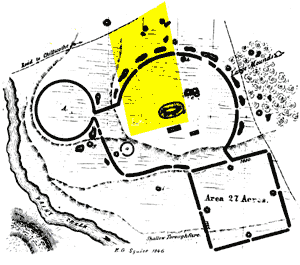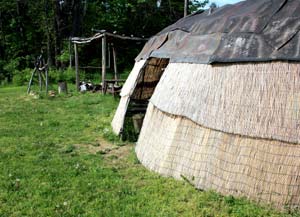
Seip Mound
Excavations have revealed that prehistoric Indian buildings existed near the earthworks. Today, visitors can see the location of some of these buildings as they are outlined by short posts in the ground. The Hopewell Culture (100 BC-AD 500) built Seip Mound for burials. This culture had a highly developed craft industry, as is evidenced by artifacts found with bodies in the burial site.
The large mound towards the center of the earthworks, and the only remaining mound left at the site was originally, 240' long by 160' wide and 30' tall. In comparison, it would have been the same size in height as a 3 story building would have nearly filled a football field.

The above is a survey conducted in the mid 1800s of the Seip Earthworks. The yellow area is all that remains of the earthworks and the burial mound. The rest was destroyed by years of farming.
Excavations at the Seip Earthworks
The first major excavations of the Seip Earthworks were between 1906 and 1903. While digging the 3 conjoined mounds (just to the northeast of the largest mound), William Mills of the Ohio Historical Society found a total of 48 burials. Besides the remains Mills found numerous objects made from copper, mica, bone, shell, and pearls.
When the large mound was explored by Henry Shetrone and Emerson Greenman between 1925 and 1928 it measured 250' long and 150' wide and 30' high. These Ohio Historical Society archeologists found 122 burials beneath the mound and 7 more interned into the top.

In 1966, the Ohio Historical Society examined for the first time part of the earth embankment and the unexcavated portion of the large mound as well as making several test excavations in the area between the mound and the outer wall. The work provided valuable information on the construction of both the embankment and the mound. Through this excavation there were indications that Hopewell Indians lived for a short periods of time within the enclosure itself.
In 1971, a team of archaeologists sponsored jointly by the Ohio Historical Society and the Ohio State University discovered the impressions of posts from a Hopewell house nearly 2000 years old. Today at the site, you can see where these original posts were located where modern posts were placed in the ground on the same location and size of the original posts.
The house measured 38.5' long and 35' wide. Based on the configuration of the posts found, it probably looked similar to a quonset hut.

Quonset hut type construction on display at Serpent Mound



 Bodies uncovered during excavation
Bodies uncovered during excavation 